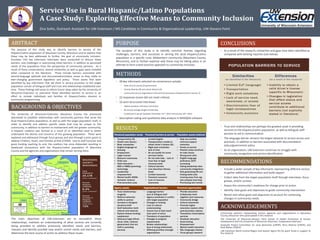
Service Use in Rural Hispanic/Latino Populations, A Case Study: Exploring Effective Means to Community Inclusion
- 1. Service Use in Rural Hispanic/Latino Populations A Case Study: Exploring Effective Means to Community Inclusion Zina Soltis, Outreach Assistant for UW-Extension / MS Candidate in Community & Organizational Leadership, UW-Stevens Point ABSTRACT The purpose of this study was to identify barriers to service of the Hispanic/Latino population of Waushara County, Wisconsin and to explore how these may be best addressed to further the goal of community inclusion. Fourteen (14) key informant interviews were conducted to discuss these barriers, and challenges in overcoming these barriers, in addition to perceived needs of the population from the perspective of community partners. As a result of these conversations, several similarities as well as gaps were revealed when compared to the literature. These include barriers associated with second-language aptitude and documentation/status issues as they relate to ever-changing government legislation and policy. Those assets that were identified by key informants that aid them in service provision to the target population consist of bilingual staff and trust and relationships established over time. These findings will serve to inform future steps taken by the University of Wisconsin-Extension to overcome these identified barriers to service in an effort to include individuals and families of Hispanic/Latino descent in community programming. BACKGROUND & OBJECTIVES The University of Wisconsin-Extension Waushara County has previously attempted to establish relationships with community partners that serve the local Hispanic/Latino population, as well as with the target population itself, in order to identify and address specific needs that may be unique to this community, in addition to barriers to involvement with the greater community. A Hispanic coalition was formed as a result of an identified need to better understand the desires and concerns of this growing population. These were explored and addressed through focus groups and also through a prior grant to address Children, Youth, and Families at Risk (CYFAR). Due to staff turnover and grant funding reaching its end, the coalition has since disbanded resulting in weakened connections with the Hispanic/Latino population of Waushara County and the agencies and organizations that remain serving them. PURPOSE METHODS RESULTS CONCLUSIONS RECOMMENDATIONS • Include a wider sample of key informants representing different sectors to gather additional information and build rapport • Collect data from the target population itself through interviews, focus groups, and/or surveys • Assess the community’s readiness for change prior to action • Identify clear goals and objectives to guide community intervention • Revisit and refine goals and objectives to account for continuing changes in community needs • 28 key informants selected via convenience sample: • State (3) and county (3) government • County libraries (8) and school districts (3) • Community service organizations (9) and local businesses (Hispanic/Latino owned, 2) • 22 responses (some did not meet criteria) • 14 semi-structured interviews: • Twelve-question interview instrument • 60 minute average length of interview • Conducted in person between December 22nd, 2015 and January 18th, 2016 • Descriptive coding and qualitative data analysis in MAXQDA software The purpose of this study is to identify common themes regarding challenges, barriers, and successes in serving the local Hispanic/Latino population in a specific rural, Midwestern community (Waushara County, Wisconsin), and to further examine why these may be taking place in an attempt to form a best-practice approach to community inclusion. The main objectives of UW-Extension are to reestablish these relationships, maintain an understanding of what services are currently being provided to address previously identified needs and barriers, reassess and identify possible new and/or unmet needs and barriers, and determine the best course of action to address these issues. • Trust and relationships are perhaps the greatest asset in providing services to the Hispanic/Latino population, as well as bilingual staff persons to aid in communication • The language barrier remains the largest obstacle to service access and provision, in addition to barriers associated with documentation status/government policy • As an organization, UW-Extension continues to struggle with community recognition and service identification • As a result of the research, similarities and gaps have been identified as compared with existing inquiries (see below) ACKNOWLEDGEMENTS Community partners representing various agencies and organizations in Waushara County, Wisconsin who participated in this research The University of Wisconsin-Stevens Point School of Health Promotion & Human Development and the University of Wisconsin-Extension, Cooperative Extension Graduate Project Committee: Dr. Jasia Steinmetz (UWSP), Terry Aittama (UWSP), and Barb Barker (UWEX) UW-Extension North Central Region and Epsilon Sigma Phi for grant funds in support of the research